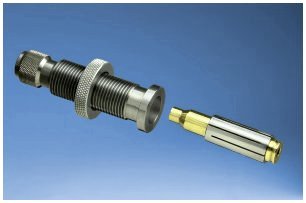This die can be used on any single stage press. Unlike conventional reloading dies,
this one threads into the press from the bottom.
Operating Instructions
This collet die is universal and works on all belted magnum cartridges (except 224, 240, 378 and 460 Weatherby). There are no extra collets required. Before each use, be sure that the die and collet are absolutely clean - especially the slots on the collet.
Always use a good high-pressure lubricant on the outside of the collet, and on your shell casing. We strongly recommend using "Imperial Sizing Die Wax" for best results. It is easy to use, it's not sticky and it is very popular with reloaders because it works. Don't use any type of liquid lube.
This collet die should only be used on cartridge cases that have already been resized with a full length (or) neck sizing die. Always headspace on the shoulder, not on the belt.
We have had belted magnum cases last more than 20 firings with maximum loads. However, always examine the inside of your cases for signs of brass stretching just above the belt.
The "top" of this die serves as a case width gauge that will identify your oversize cases. The cases that don't fit inside should be resized with the collet die. This avoids overworking the brass and insures a perfect fit in your chamber.
Cases that are fired repeatedly without ever using the collet resizing die can swell beyond recovery.
Always check fired cases to see if they will drop freely into the top of the die. Remember that the size of different rifle chambers can vary considerably.
Note that the collet is slightly tapered. The small end is identified by a 45 degree cut on that end. Slide the collet over the case and be sure that it contacts the belt. The small end of the collet must face the mouth of the case.
Remove the locking collar and insert the die (from the bottom) into your press as far as it will go. Adjust the die all the way into the press, as far as it will go. Then replace the locking collar on top of the die. The ram of your press (with shell holder inserted) should have a small clearance under the die - if possible. This setting will allow you to resize the expansion ring on your case (just above the belt) to .510" or as needed.
If resizing seems to require too much pressure, withdraw the case, rotate it, and press it into the die again. Be sure the collet stays seated against the belt. The collet can easily be separated from the case by inverting it, holding it against the shell holder and carefully use your press to push the case out of your collet and into the die.
If you have any questions about the proper use of your belted magnum collet resizing die, contact Larry Willis at Innovative Technologies at
it@mpinet.net (or) call at 407-695-2685.



 Reply With Quote
Reply With Quote



Bookmarks